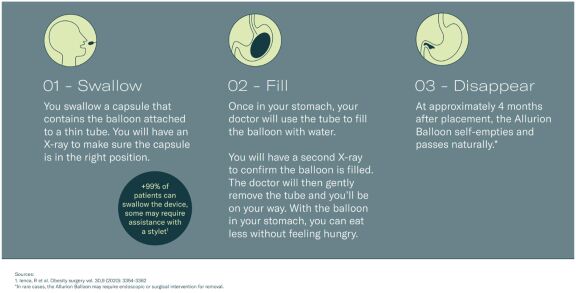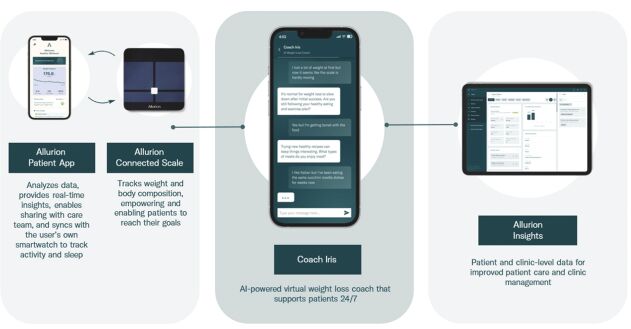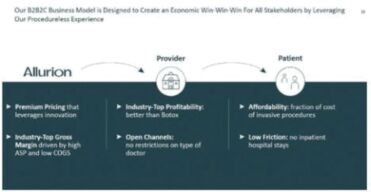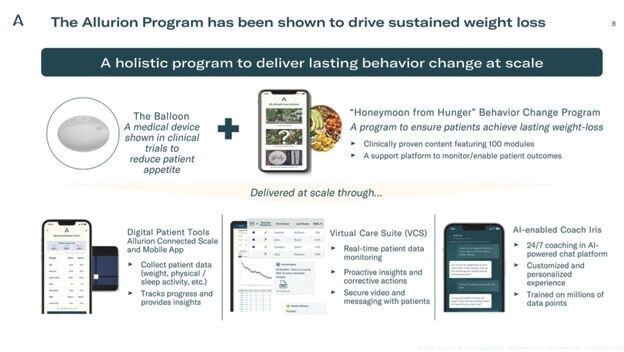The information in this preliminary prospectus is not complete and may be changed. These securities may not be issued until the registration statement filed with the U.S. Securities and Exchange Commission is effective. This preliminary prospectus is not an offer to sell these securities and does not constitute the solicitation of an offer to buy these securities in any jurisdiction where the offer or sale is not permitted.
SUBJECT TO COMPLETION, DATED JUNE 21, 2024
PRELIMINARY PROSPECTUS

ALLURION TECHNOLOGIES, INC.
Up To 56,548,268 Shares of Common Stock
This prospectus relates to the resale from time to time by the selling securityholders named in this prospectus (collectively, the “Selling Securityholders”), or their permitted transferees (after the expiration of any applicable lock-up period), of up to 37,418,547 shares of our common stock, par value $0.0001 per share (“Common Stock”) issued or issuable in connection with the business combination (the “Business Combination”) between Allurion Technologies, Inc. (“Allurion”) and Compute Health Acquisition Corp. (“Compute Health”) pursuant to that certain Business Combination Agreement, dated as of February 9, 2023 (as amended, the “Business Combination Agreement”), by and among Allurion, the entity formerly known as Allurion Technologies, Inc. prior to the Business Combination (now known as Allurion Technologies, LLC or “Legacy Allurion”), Compute Health, Compute Health Corp. (“Merger Sub I”) and Compute Health LLC (“Merger Sub II” and, together with Merger Sub I, the “Merger Subs”), including (i) (a) 26,481,445 shares of Common Stock issued to certain Selling Securityholders for their portion of the Aggregate Intermediate Merger Closing Merger Consideration (as defined in this prospectus) in connection with the consummation of the Business Combination in exchange for shares of common stock of Legacy Allurion purchased at effective purchase prices ranging from $0.01 per share to $18.19 per share of Common Stock and (b) 2,737,143 shares of Common Stock issued to Compute Health Sponsor LLC (the “Sponsor”) in connection with the Business Combination in exchange for shares of Compute Health Class A common stock purchased at an effective purchase price per share of $7.04 (collectively clauses (a) and (b), the “Merger Consideration Shares”), (ii) 1,400,000 shares of Common Stock (“Backstop Shares”) issued to certain entities that have engaged RTW Investments, LP as investment manager (collectively, “RTW”) and CFIP2 ALLE LLC (the “Fortress Investor”) pursuant to the Backstop Agreement (the “Backstop Agreement”), dated as of May 2, 2023, by and among Hunter Ventures Limited (“HVL”), Allurion, Legacy Allurion, RTW and the Fortress Investor, an affiliate of Fortress Credit Corp. (“Fortress”) at no cash cost to RTW or the Fortress Investor as consideration for RTW’s and the Fortress Investor’s respective purchase obligations thereunder, (iii) 387,696 shares of Common Stock (the “HVL Additional Shares”) issued to HVL pursuant to the Side Letter Termination Agreement, dated as of May 2, 2023, by and among Allurion, Legacy Allurion, Romulus Growth Allurion L.P. and HVL (the “HVL Termination Agreement”) at an effective purchase price of $5.00 per share, (iv) 250,000 shares of Common Stock issued to RTW (the “Additional RTW Shares”) pursuant to that certain amended and restated letter agreement, dated as of May 2, 2023, by and among Allurion, Legacy Allurion, Compute Health, Merger Sub II and RTW (the “Amended and Restated RTW Side Letter”) at no cash cost to RTW, (v) 250,000 shares of Common Stock (the “Additional Fortress Shares”) issued to the Fortress Investor pursuant to the Credit Agreement and Guaranty, dated as of August 1, 2023, by and among Legacy Allurion, as the borrower, Allurion, the guarantors from time to time party thereto, the lenders from time to time party thereto and Fortress, as administrative agent (the “Fortress Credit Agreement”) at no cash cost to Fortress or the Fortress Investor as partial consideration for loans made by Fortress thereunder, (vi) 525,568 shares of Common Stock issued to Compute Health Sponsor LLC (the “Sponsor”) pursuant to the conversion of certain amounts of certain loans borrowed by Compute Health from the Sponsor or any of its affiliates that were outstanding as of the consummation of the Business Combination at a conversion price of $7.04 per share (the “Sponsor Loan Equity Issuance”), and (vii) 5,386,695 shares of Common Stock (the “PIPE Shares”) purchased at the closing of the Business Combination by a number of subscribers (the “PIPE Investors”) at a subscription price of $7.04 per share pursuant to separate PIPE subscription agreements, each dated as of February 9, 2023, by and among Compute Health, Allurion and such PIPE Investors (the “PIPE Subscription Agreements”). For more information about the Common Stock offered for resale by the Selling Securityholders pursuant to this prospectus, including the purchase prices paid by such Selling Securityholders for their securities, see “Information Related to Offered Securities” beginning on page 22 of this prospectus.
Due to the significant number of redemptions of Compute Health Class A common stock in connection with the Business Combination, there was a significantly lower number of shares of Compute Health Class A common stock that converted into shares of our Common Stock in connection with the Business Combination. As a result, the shares of our Common Stock being registered for resale (a substantial portion of which may not be resold until the expiration of the applicable lock-up period) are anticipated to constitute a considerable percentage of our public float. Additionally, a significant portion of the shares of our Common Stock being registered for resale were originally purchased by Selling Securityholders pursuant to investments in Legacy Allurion that date from 2013 onwards at prices considerably below the current market price of our Common Stock. This discrepancy in purchase prices may have an impact on the market perception of our Common Stock’s value and could increase the volatility of the market price of our Common Stock or result in a significant decline in the public trading price of our Common Stock. The registration of these shares for resale creates the possibility of a significant increase in the supply of our Common Stock in the market. The increased supply, coupled with the potential disparity in purchase prices, may lead to heightened selling pressure, which could negatively affect the public trading price of our Common Stock. We will not receive any proceeds from the resale of Common Stock by the Selling Securityholders pursuant to this prospectus.
This prospectus also relates to (i) the resale of up to an aggregate of 369,883 shares of Common Stock issuable upon the exercise of warrants to purchase shares of our Common Stock, at exercise prices that range from $0.02 per share to $12.14 per share, that were converted from Legacy Allurion Warrants (as defined in this prospectus) in connection with the Business Combination (the “Rollover Warrants”) and (ii) the issuance by us of up to 18,759,838 shares of Common Stock issuable upon the exercise of public warrants to purchase shares of our Common Stock, at an exercise price of $8.10 per share, that were originally issued in the initial public offering of Compute Health (the “Public Warrants”). We will receive the proceeds from any exercise of any Rollover Warrants or Public Warrants for cash, but not from the resale of any shares of Common Stock issuable upon exercise of such Rollover Warrants or Public Warrants, which amount of aggregate proceeds, assuming the exercise of all Rollover Warrants would be $2.1 million and assuming the exercise of all Public Warrants would be $152.0 million. We believe the likelihood that warrant holders will exercise their Rollover Warrants or Public Warrants, and therefore the amount of cash proceeds that we would receive, is dependent upon the market price of our Common Stock. As further discussed in this prospectus, as of the date of this prospectus, all of our Public Warrants and a significant portion of our Rollover Warrants, are “out of the money,” meaning the exercise price is higher than the market price of our Common Stock. Holders of such “out of the money” Warrants are not likely to exercise such Warrants.
We will pay the expenses, other than any underwriting discounts and commissions, associated with the resale of securities pursuant to this prospectus. The Selling Securityholders will bear all commissions and discounts, if any, attributable to their sales of the shares of Common Stock. We are registering the securities for resale pursuant to the Selling Securityholders’ registration rights under the Investor Rights and Lock-up Agreement, dated August 1, 2023 by and among us, the Sponsor, certain Legacy Allurion Stockholders and certain other persons, the PIPE Subscription Agreements and the Fortress Credit Agreement. Our registration of the securities covered by this prospectus does not mean that either we or the Selling Securityholders will issue, offer or sell, as applicable, any of the securities. The Selling Securityholders may offer and sell the securities covered by this prospectus in a number of different ways and at varying prices. We provide more information about how the Selling Securityholders may sell the shares in the section entitled “Plan of Distribution.”
This prospectus provides you with a general description of such securities and the general manner in which the Selling Securityholders may offer or sell the securities. More specific terms of any securities that the Selling Securityholders may offer or sell may be provided in a prospectus supplement that describes, among other things, the specific amounts and prices of the securities being offered and the terms of the offering. The prospectus supplement may also add, update or change information contained in this prospectus.
You should read this prospectus and any prospectus supplement or amendment carefully before you invest in our securities.
Our Common Stock is listed on The New York Stock Exchange (“NYSE”) under the symbol “ALUR.” On June 20, 2024, the last quoted sale price for the shares of our Common Stock as reported on the NYSE was $2.60 per share.
Our public warrants are listed on the NYSE under the symbol “ALUR WS” and on June 20, 2024, the last quoted sale price for our public warrants as reported on the NYSE was $0.2696 per warrant.
We are an “emerging growth company” under applicable federal securities laws and will be subject to reduced public company reporting requirements.
Investing in our securities involves a high degree of risk. Before buying any securities, you should carefully read the discussion of the risks of investing in our securities in “Risk Factors” beginning on page 26 of this prospectus.
Neither the Securities and Exchange Commission nor any state securities commission has approved or disapproved of these securities or passed upon the adequacy or accuracy of this prospectus. Any representation to the contrary is a criminal offense.
The date of this prospectus is June 21, 2024.






